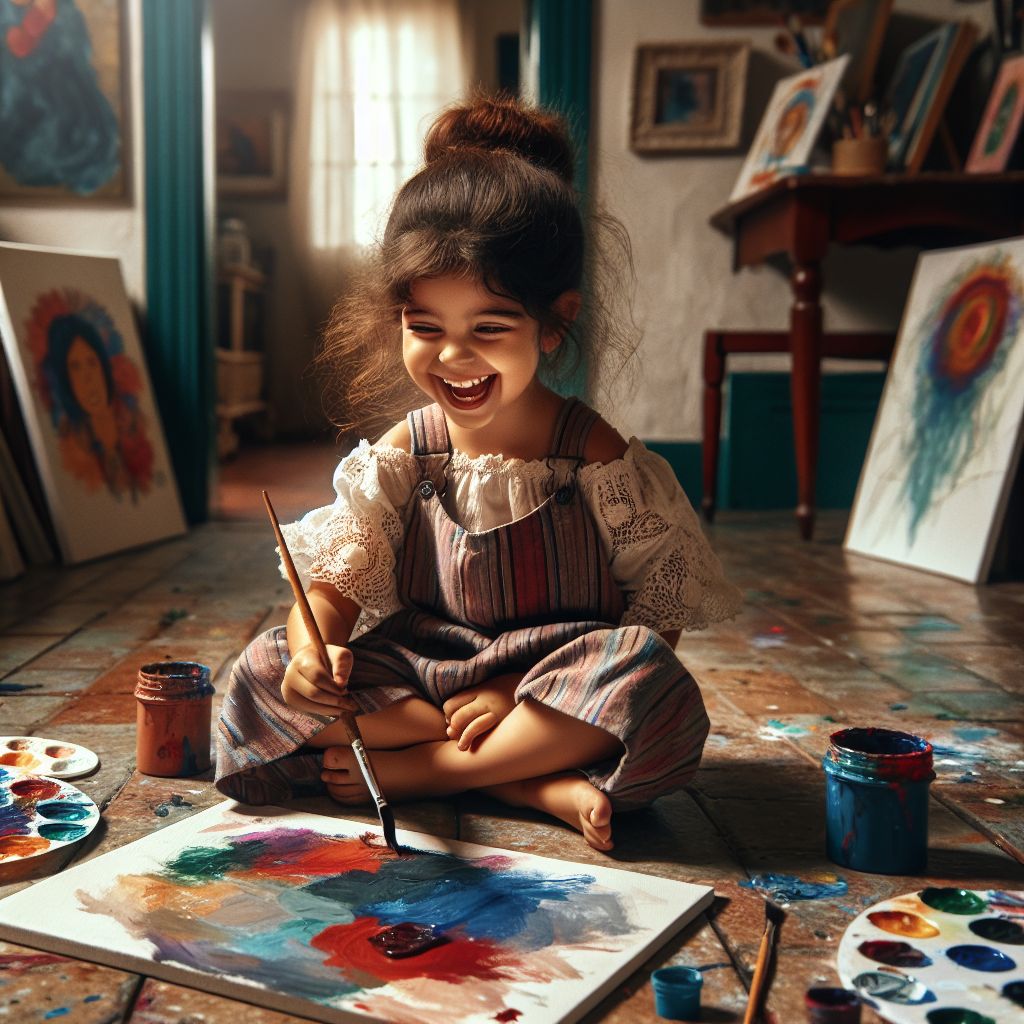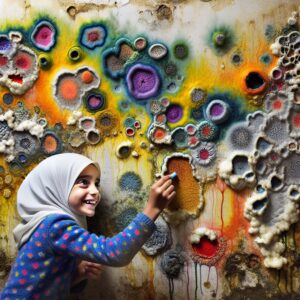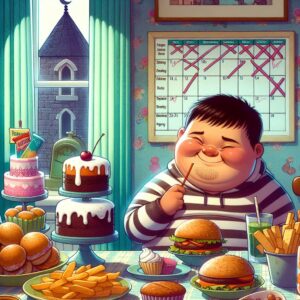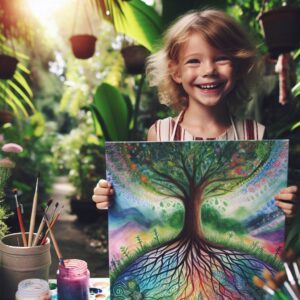-
Creativity is a powerful tool for fostering happiness in children.
-
Engaging in creative activities like drawing and painting can enhance emotional growth and self-esteem.
-
Artistic expression is not only fun but also contributes to cognitive development and problem-solving skills.
-
Parents can encourage creativity by providing a supportive environment and praising effort.
-
Visual arts can be adapted for children of all ages and abilities, offering a versatile path to joy and learning.

How Creativity Leads to Happiness in Children
It’s a bright Saturday morning, and the living room is abuzz with the laughter of children. On the floor, there’s a vibrant chaos of crayons and paper. This isn’t just play—it’s a joyous dance of creativity that’s doing more for these kids than meets the eye. Creativity, in its purest form, is like a key that unlocks the doors to a child’s happiness and well-being.
The Science of Creativity and Positive Emotions
Why does creativity matter so much? It’s simple. When kids create, they’re not just making pretty pictures; they’re building new neural pathways in their brains. Every stroke of paint, every crayon mark is a step towards a more joyful, resilient mind. Think of it as a workout for the brain, with happiness as the ultimate reward.
But don’t just take my word for it. Studies show that creative activities can reduce stress and anxiety in children. They get to express their feelings in a safe, tangible way, which can be especially helpful when they can’t find the words to describe what they’re going through.
Most importantly, creativity can lead to positive emotions, which are the building blocks of happiness. When children engage in artistic endeavors, they experience a sense of accomplishment and pride that boosts their mood and self-esteem.
Case Studies: Creative Activities and Childhood Joy
Let’s talk real examples. There was this one time a group of children were given the task to create their own superheroes. The excitement was palpable as they discussed powers and costumes. The end result? Not only a colorful display of original heroes but also a group of kids beaming with pride and happiness.
Another case involved a quiet child who found her voice through painting. With each brushstroke, she grew more confident, and her joy became as vivid as the colors on her canvas. These aren’t isolated incidents; they’re daily occurrences in the world of child creativity.
Building a Happy Brain through Artistic Expression
Artistic expression isn’t just about the end product; it’s about the journey. When kids are encouraged to express themselves, they’re also learning critical thinking and problem-solving skills. They learn to make choices and to see the results of their actions, all within the safe confines of a piece of paper.
But how do you make this happen? It starts with environment and encouragement. Create a space where your child can be messy and free in their artistic pursuits. Provide them with a variety of materials, and let them explore. It’s not about directing their every move, but about giving them the tools to discover their own paths to happiness.
And when they do create, praise their effort and process, not just the final piece. This teaches them to value their own hard work and to find joy in the act of creation itself.
Art is a language that speaks directly to the heart, and by nurturing it in children, we’re giving them a way to communicate their joy, their fears, and their dreams. It’s a gift that will stay with them throughout their lives, coloring their world with happiness and creativity.
Picturing Positivity: Drawing, Painting and Emotional Growth
Drawing and painting are more than just fun activities—they’re a canvas for emotional growth. When children pick up a pencil or brush, they’re not just making art; they’re expressing their inner world. This expression provides a safe outlet for emotions, helping them understand and process their feelings. It’s like each picture tells a story, and with every story, they grow a little more.
For example, drawing has been used therapeutically with children who have experienced trauma. Through their drawings, they can communicate thoughts and emotions that might be too difficult to express verbally. This can be a powerful step in their healing process and can contribute to a greater sense of happiness and well-being.
The Texture of Happiness: Sculpture and Sensory Exploration
Let’s not forget about the tactile world of sculpture. Working with materials like clay or dough, children engage their sense of touch, which can be incredibly grounding and soothing. It’s a hands-on experience that can help them connect to the moment, a practice akin to mindfulness.
As they mold and shape, they’re not just creating three-dimensional art; they’re also sculpting their emotional resilience. The act of manipulating materials can help children feel in control and can provide a sense of accomplishment when they see their creation take form.
Key Takeaways
-
Creativity is a vital pathway to happiness for children, offering emotional, cognitive, and social benefits.
-
Drawing and painting allow kids to express and process their emotions, contributing to emotional maturity.
-
Sculpture and other tactile arts provide sensory experiences that can improve focus, mindfulness, and emotional regulation.
-
Parents and caregivers can support children’s happiness by providing materials, space, and encouragement for creative expression.
-
Praising the creative process rather than the outcome fosters a growth mindset and builds self-esteem.
Engaging the Five Senses: Creative Artwork for Holistic Happiness
Creative activities that engage all five senses offer a holistic approach to happiness. Consider a project where children create their own scented playdough. As they mix ingredients, they’re learning about cause and effect. As they choose scents, they’re making decisions that reflect their preferences, and as they play with the dough, they’re engaging touch, smell, and even sight with vibrant colors.
This multisensory approach can enhance learning and retention of information. It also helps children with different learning styles to connect with the activity in a way that suits them best, leading to a more inclusive and joyful creative experience.
Display and Praise: How Acknowledging Artistic Effort Boosts Self-Esteem
When a child’s artwork finds a place on the fridge or a family gallery wall, it sends a powerful message: “Your work matters. You matter.” This recognition goes a long way in boosting a child’s self-esteem. It’s important to focus on praising the effort they put into their work, not just the aesthetic of the final product.
For instance, rather than saying “That’s a beautiful painting,” you might say, “I can see you worked really hard on this, and I love how you mixed the colors.” This kind of praise encourages children to value their own effort and creativity, fostering a sense of accomplishment and intrinsic motivation.
Art as a Family Activity: Bonding over Brushes and Canvases
Art doesn’t have to be a solo activity. In fact, it can be a wonderful way for families to bond. Organizing a family painting day, where everyone works on their own piece or contributes to a collective artwork, not only creates a fun family memory but also models the value of creativity and self-expression.
These shared experiences can strengthen family ties and provide a platform for open communication. It’s a chance for parents to share in their child’s joy and for children to feel supported in their creative endeavors.
Frequently Asked Questions (FAQ)
Parents often have questions about how best to integrate creativity into their child’s life to foster happiness. Here are some common questions and practical answers:
What specific visual arts activities are most beneficial for children’s happiness?
Activities that allow for self-expression and choice, such as free drawing, painting, or sculpting, are particularly beneficial. These activities encourage children to make decisions, use their imagination, and express their feelings, all of which contribute to happiness.
How can parents without artistic skills encourage creativity in their children?
Parents don’t need to be skilled artists to encourage creativity. It’s all about providing the space, time, and materials for children to explore and create. Most importantly, show interest in your child’s creative process and offer positive reinforcement.
Are there any recommended age-appropriate art projects?
Yes, there are many! For toddlers, finger painting and playdough are great options. School-aged children might enjoy more structured activities like making collages or building with recyclable materials. For older kids, try more complex projects like stop-motion animation or DIY crafts.
What are the long-term benefits of engaging children in visual arts?
Engaging in the visual arts can improve fine motor skills, enhance problem-solving abilities, and foster a sense of cultural awareness. It can also contribute to emotional intelligence and resilience, setting children up for long-term success and happiness.
Can visual arts help children with special needs express happiness?
Absolutely. Visual arts can be especially beneficial for children with special needs, providing a non-verbal way to express emotions and experiences. It can also offer a sense of achievement and can be tailored to each child’s abilities and interests.
-
Creativity is a powerful tool for fostering happiness in children.
-
Engaging in creative activities like drawing and painting can enhance emotional growth and self-esteem.
-
Artistic expression is not only fun but also contributes to cognitive development and problem-solving skills.
-
Parents can encourage creativity by providing a supportive environment and praising effort.
-
Visual arts can be adapted for children of all ages and abilities, offering a versatile path to joy and learning.
Stanley Lang, M.D. has been in active medical practice since 1978. He has been a family physician during these years with detailed experience in all age groups including delivering babies for several years. He has been a pioneer in developing models of wholistic health care that bring health to the whole person. He has particularly focussed on reversing Chronic Stress effects on the body. He is the creator of the Shalom Method for Wholistic Health, and he has created several online programs that allow patients to naturally self manage their problems including “The Natural Lyme disease Treatment Program”, the “Menopause Balancing Program”, “The Happy Healthy Child” program plus many others.



